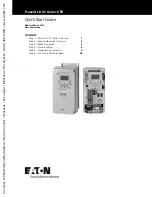
Step 5—Standard Parameter List
PowerXL DG1 Series Adjustable Frequency Drives
MN040012EN—March 2014
www.eaton.com
9
Step 5—Standard Parameter List
Introduction
The Standard Application is typically used in basic motor
control scenarios where multiple pump control, PID loops,
or advanced control loops are not required. It provides the
ability for the user to define its local and remote control and
reference signals. In addition there is the ability to scale the
analog input and output signals to be read based off the
desired motor response. There are also 8 digital inputs,
3 relay outputs, and 1 digital output that can be programmed
to allow for control schemes that require the drive to have
certain functions. It provides full customization on the motor
control sequence with the ability to be in frequency or speed
control mode, and tuning of the V/Hz curve can be selected.
Drive/Motor protections can be customized to defined
actions for added user control. Below is a list of other
features that are available in the Standard Application.
Standard Application includes functions:
●
Selectable digital input function
●
Selectable digital output function
●
Reference filter, scaling, inversion, offset and range
●
Output signal filter, scaling, inversion, offset and range
●
Selectable analog output function
●
Programmable start/stop and reverse signal logic
●
Two independent set of Acceleration/Deceleration ramps
●
S curves
●
Skip frequency
●
Start source (Local/Remote control function)
●
Reference source
●
Flying start
●
Jog
●
Volts per Hertz control
●
Real time clock function—RTC time display
●
Drive temperature limit supervision
●
Output frequency 1 limit supervision
●
Output frequency 2 limit supervision
●
Torque limit supervision
●
Reference frequency limit supervision
●
Power limit supervision
●
Analog input limit supervision
●
Auto restart
●
Power loss ride through
●
Trend buffer
●
Programmable switching frequency
●
Multi-Preset speeds
●
Emergency stop
●
Line start lockout
●
Fan control
●
DC brake
●
Flux brake
●
Dynamic brake
I/O Controls
●
“Terminal To Function” (TTF) Programming
The design behind the programming of the digital inputs in
the DG1 drive is to use “Terminal To Function”
programming, which is composed of multiple functions that
get assigned a digital input to that function. The parameters
in the drive are set up with specific functions and by defining
the digital input and slot in some cases, depending on which
options are available. For use of the drives control board
inputs, they will be referred to as DigIN:1 through DigIN:8.
When additional option cards are used, they will be defined
as DigIN:X:IOY:Z. The X indicates the slot that the card is
being installed in, which will be either A or B. The IOY
determines the type of card it is, which would be IO1 or IO5.
The Z indicates which input is being used on that available
option card.
●
“Function To Terminal” (FTT) Programming
The design behind the programming of the relay outputs
and digital output in the DG1 drive is to use “Function To
Terminal” programming. It is composed of a terminal, be it a
relay output or a digital output, that is assigned a parameter.
Within that parameter, it has different functions that can be set.
The parameters of the Standard Application are explained
on
Page 11
of this manual, “Description of Parameters.” The
explanations are arranged according to the parameter
number.
Courtesy
of
CMA/Flodyne/Hydradyne
▪
Motion
Control
▪
Hydraulic
▪
Pneumatic
▪
Electrical
▪
Mechanical
▪
(800)
426-5480
▪
www.cmafh.com












































